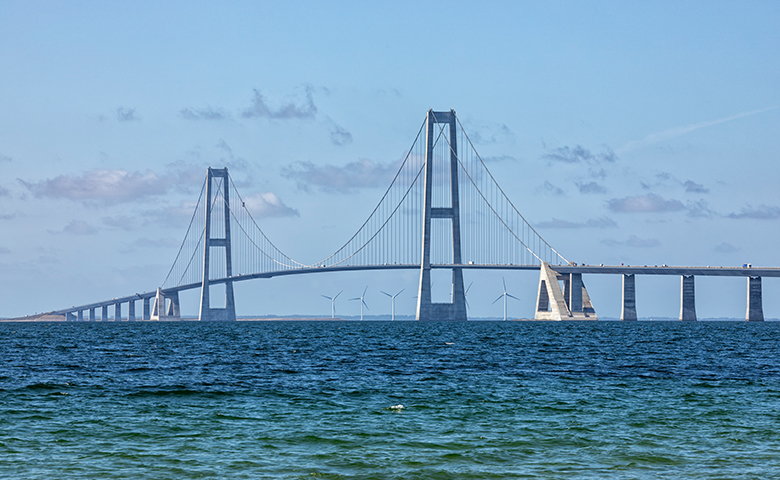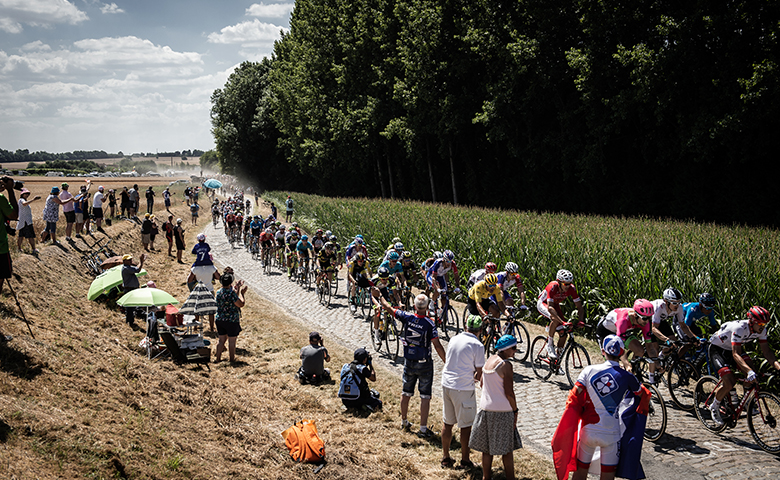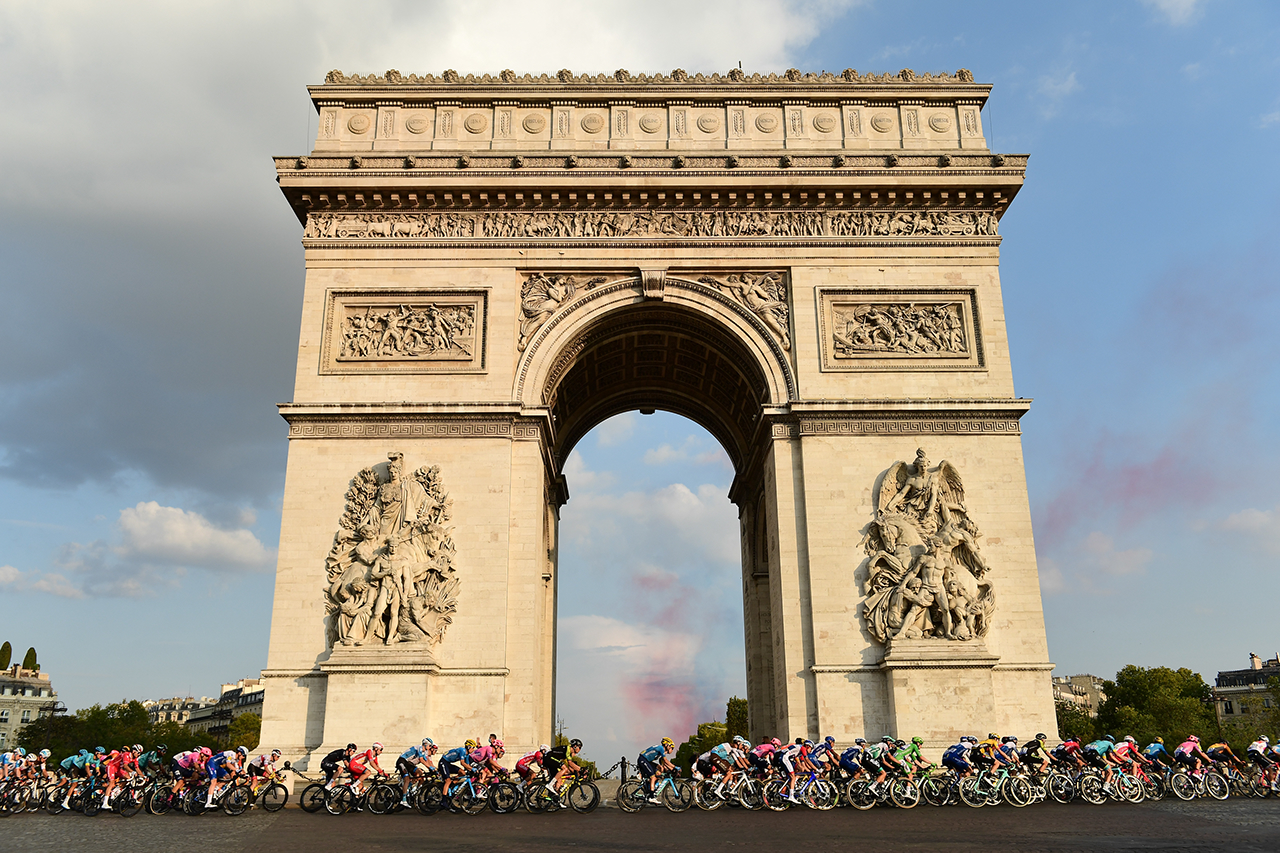
# Cycling
Tour de France travel
Must-see sights and must-do experiences

The route of the Tour de France 2022
Tour de France isn't just one of the biggest sporting events on the planet, it's also the world's largest travel advertisement!
This year’s race is truly international as it passes through some of the most scenic parts of Denmark, France, and border areas of Belgium and Switzerland.
So, whether you prefer to be glued to the sofa to watch 100 hours of televised footage, or simply want to be inspired for your next holiday, we've got you covered with tips and tricks to make the event memorable.
Read on for our five highlights from the Tour de France route, stage-by-stage, and find out why they’re worth a visit all year round.
Stage 1 to 3: Denmark
Cycling is a way of life in Denmark with 9 out of 10 people owning a bicycle. It sure helps that the country’s terrain is primarily flat. The first 3 stages of the 109th edition of the Tour de France will take place in the southern part of the country with the Grand Départ at Copenhagen on July 1st. After the 178 km mark, the track winds its way through islands bursting with Nordic fauna such as Zealand and Funen to the hills in Vejle, and past the UNESCO World Heritage site of Christiansfeld for a final sprint to the finish line in Sønderborg near the German border.
Tour tip: Only one side of the 18 km Great Belt Fixed Link bridge connecting the islands of Zealand and Funen is being cordoned off for the race. Unfortunately, Tour de France enthusiasts will have to contend with a spot in front of the TV to witness the sheer endurance of riders as they brave fierce winds while crossing Europe’s largest suspension bridge.
Taste of Denmark: If there is a quintessential word for Danish culture, it is Hygge. This also extends to the kind of food that brings comfort such as smorrebrod. The open-faced sandwiches are made with rye bread and a variety of toppings so there’s something for every palate.
Cycling tip: The Tour de France passes through the Jutland peninsula on the Baltic Coast during Stage 3. Head to Limfjord, with 180 km of bays and islands, it is Denmark’s largest fjord area. The place was a Viking favorite over a thousand years ago and predominantly consists of flat stretches and gentle rolling landscapes that make for easy biking.
 TDF riders will brave strong winds as they pass through Europe’s largest suspension bridge during Stage 2
TDF riders will brave strong winds as they pass through Europe’s largest suspension bridge during Stage 2
Stage 5: The cobbled sectors of Lille to Arenberg
The Tour de France goes to the ancient cobbles, where all bets are off and there is potential to completely rewrite the race. The 155 km stretch utilizes 11 cobbled sectors amounting to 19.5 km of jagged, unkempt, and unruly pave. The route extends all the way to Roubaix on the border of Belgium to finish for the third time at Arenberg. Your cheers mean more here!
Tour tip: If you want to get in on the action, there is no better place to do so than at the cobbled sector, known among cycling enthusiasts as “the monument”. Keep your mobile phone cameras focused on riders as they bob on the cobble, it is the best footage you will ever get.
Taste of Flanders: Mining was a major industry in the Flanders region, and those who survived the arduous day often sought refuge in taverns and bars. The region is known for its wide selection of beers and gin. Owing to its proximity to Belgium, you can find a lot of similarity in cuisine, such as waffles and potted meat. Teetotalers can wash it all down with root chicory, another staple from the region used as a coffee substitute.
Cycling tip: Why not get your own shot at the cobbles at the Arenberg Forest? The Tour de France will be giving this sector a miss, so it’s all the easier to find accommodation and enjoy the heavily forested route made famous by the Paris-Roubaix.
 TDF riders bob their way across 19.5 km of cobbles during Stage 5. © A.S.O/ Pauline Ballet
TDF riders bob their way across 19.5 km of cobbles during Stage 5. © A.S.O/ Pauline Ballet
Stage 8 to 10: French Alps
The towering peaks, winding roads and spectacular vistas of the French Alps are a marvel at any time of the year. In winter, they are home to some of the most famous and exclusive ski resorts in the world. In summer, they offer excellent hiking, mountain biking, as well as quaint villages and serene alpine lakes. During the Tour de France, they are the place where iconic scenes play out, legendary mountain stages are decided and champions are crowned. Be sure to get there early for a good spot!
Tour tip: Alpe d'Huez, probably the most iconic summit finish, usually draws hundreds of thousands of supporters from all corners of the globe and temporarily turns the mountain road into a veritable festival site. It’s not on this year’s route, but that doesn’t mean amateur cyclists can’t incorporate it into their personal tour. To tackle the famous 21 bends, you need to be in seriously good shape!
Taste of the Alps: The regional cuisine is extremely cheesy, with fondue, raclette and Savoie specialty Tartiflette all featured heavily on chalet menus. Don’t over-indulge if you’re watching from your couch!
Cycling tip: Once you leave the Autoroute at Grenoble, there’s no such thing as a non-scenic road as you head into the Alps. La Route des Grandes Alpes, which stretches all the way from Lake Geneva to the Mediterranean, takes in iconic TDF highlights like the Col du Galibier and Col d’Izoard along the way.
 The French Alps are beautiful in summer and winter
The French Alps are beautiful in summer and winter
Stage 15 to 16: Carcassonne
The finish of stage 13 and start of stage 14 in this walled city offer an opportunity to explore some history alongside the sporting heritage of the region. The city’s medieval fortress, a UNESCO World Heritage site, draws huge crowds during high season, so avoid it during the summer – unless, of course, you want to be there for the Tour de France.
Tour tip: Unlike some remote mountain towns that can be hard to reach and even harder to find accommodation in, the city’s infrastructure makes it an easier race viewing destination. With the finish of one stage, followed by the start of the next, it offers two opportunities to watch riders in an atmospheric setting before they head off for the Pyrenees.
Taste of Carcassonne: If you have a sweet tooth, sample the eponymous Carcassonnais pastries and a whole host of other delicacies.
Cycling tip: The Canal du Midi is perfect for cyclists, but you can also follow it by car. The 17th-century canal is part of the 500-kilometer Canal de Deux Mers, connecting the Atlantic to the Mediterranean..
 Carcassonne will see two TDF stages in 2021
Carcassonne will see two TDF stages in 2021
Final stage: Paris
The top of the Eiffel tower, a Seine boat tour, a visit to the Louvre … and viewing the final stage of the Tour de France at the finish line. There are many reasons to visit Paris, but for cycling fans, a front-row, first-hand experience of this key race moment is the must-do experience!
Tour tip: The Tour de France finish line has been at the Arc de Triomphe since 1975. While the cyclists suffer a bumpy ride on the cobblestones of the Champs-Elysees, the spectators lining the street feel the goosebumps leading up to the grand finale.
Taste of Paris: The final stage is traditionally accompanied by a glass of bubbly and a charcuterie platter, especially if it’s a nail-biting field sprint to the finish line, and of course to toast the 2022 champion and the lanterne rouge.
Cycling tip: Paris has become increasingly cyclist-friendly in recent years, so hop on one of the omnipresent city bikes and choose a sightseeing route.
 Arc de Triomphe Tour de France finish line © A.S.O/Alex Broadway
Arc de Triomphe Tour de France finish line © A.S.O/Alex Broadway
